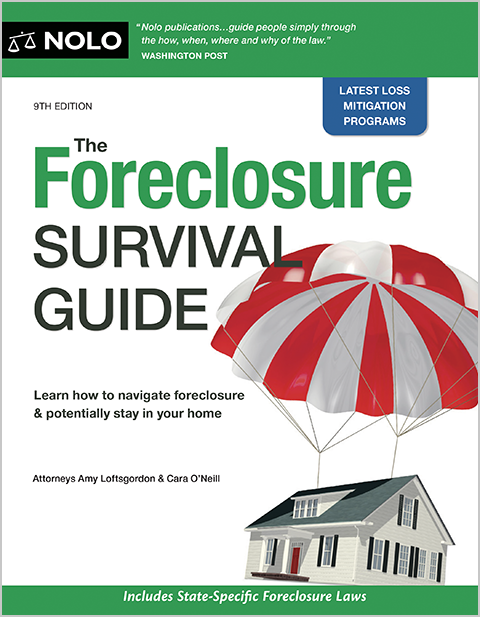Learn the steps to foreclosure in Washington, D.C.
Before the foreclosure crisis, federal and state laws regulating mortgage servicers and foreclosure procedures were relatively limited and tended to favor foreclosing lenders. However, many federal and state laws now protect borrowers. Servicers must provide borrowers with loss mitigation opportunities, account for each foreclosure step, and carefully comply with foreclosure laws.
Also, most people who take out a loan to buy a residential property in the District of Columbia sign a promissory note and deed of trust. These documents give homeowners contractual rights after defaulting on the loan.
So, don't get caught off guard if you're a homeowner behind in mortgage payments. Learn the foreclosure process and foreclosure laws in Washington, D.C.
- What Are My Rights During Foreclosure in Washington, D.C.?
- Preforeclosure Steps: What Happens Before a Foreclosure Starts in Washington, D.C.
- When Can a Foreclosure Start in the District of Columbia?
- Foreclosure Procedures in Washington, D.C.
- How Judicial Foreclosures Work in Washington, D.C.
- How Nonjudicial Foreclosures Work in Washington, D.C.
- How Do Foreclosure Sales Work in Washington, D.C.?
- Avoiding Foreclosure: Options Available for Borrowers During Foreclosure in Washington, D.C.
- Are Deficiency Judgments Allowed in Washington, D.C.?
- Getting Foreclosure Help
What Are My Rights During Foreclosure in Washington, D.C.?
In a Washington, D.C., foreclosure, you'll most likely get the right to:
- get a preforeclosure notice called a "breach letter"
- apply for loss mitigation
- get notice of the foreclosure
- receive special protections if you're in the military
- pay the overdue payments, plus fees and costs, to bring the loan current
- pay off the loan to prevent a foreclosure sale, and
- get any excess money after a foreclosure sale.
Once you understand the foreclosure process in Washington, D.C., and your rights, you can make the most of your situation and, hopefully, work out a way to save your home or at least get through the process with as little anxiety as possible.
Preforeclosure Steps: What Happens Before a Foreclosure Starts in Washington, D.C.
The period after you fall behind in payments, but before a foreclosure officially starts, is generally called the "preforeclosure" stage. (Sometimes, people refer to the period before a foreclosure sale happens as "preforeclosure," too.)
Here's generally what happens during the preforeclosure period:
- the servicer can charge you various fees
- in most cases, federal law requires the servicer to let you know about ways to avoid foreclosure and
- most mortgage contracts require the servicer to send you a breach letter (a preforeclosure notice).
When Can a Foreclosure Start in the District of Columbia?
Under federal law, the servicer usually can't officially begin a foreclosure until you're more than 120 days past due on payments, subject to a couple of exceptions. (12 C.F.R. § 1024.41 (2025).) This 120-day period provides most homeowners ample opportunity to submit a loss mitigation application to the servicer.
Foreclosure Procedures in Washington, D.C.
Foreclosures in Washington, D.C., can be judicial (through the court) or nonjudicial (an out-of-court process). In the past, most foreclosures in the District of Columbia were nonjudicial. However, because the District implemented a foreclosure mediation program to accompany the nonjudicial process, lenders sometimes opt to foreclose in court to avoid mediation.
Because a foreclosure in the District of Columbia could be judicial or nonjudicial, this article covers both processes.
How Judicial Foreclosures Work in Washington, D.C.
A judicial foreclosure begins when the lender files a lawsuit asking a court for an order allowing a foreclosure sale. The lender gives notice of the suit by serving you a summons and complaint. If you don't respond to the suit, the lender will ask the court for, and probably receive, a default judgment, allowing it to hold a foreclosure sale.
But if you choose to defend the foreclosure lawsuit, the case will go through the litigation process. The lender might then ask the court to grant summary judgment. A summary judgment motion asks that the court grant judgment in favor of the lender because there's no dispute about the critical aspects of the case.
If the court grants summary judgment for the lender—or you lose at trial—the judge will enter a judgment and order your home sold.
How Nonjudicial Foreclosures Work in Washington, D.C.
The lender mails a notice of default to the borrower, which includes the amount required to reinstate the loan. The lender must also record the notice of default in the land records, which is the first official step in the nonjudicial process. (D.C. Code § 42-815, § 42-815.02 (2025).)
Along with the notice of default, the lender has to send the borrower details about the foreclosure mediation program. (D.C. Code § 42-815.02 (2025).) In mediation, the borrower, lender, and a neutral party (the mediator) meet to discuss whether the borrower qualifies for a foreclosure alternative. To participate in mediation, the borrower has to send in the provided mediation election form no later than 30 days after the form is mailed.
Next, if the borrower and lender can't work out a way to avoid foreclosure, the lender sends a notice of the intention to foreclose to the borrower and a copy to the mayor at least 30 days before the sale. The 30-day period starts on the date the mayor receives the notice. (D.C. Code § 42-815 (2025).) The notice includes the sale date.
The deed of trust will outline any public notice requirements. Notice about the sale is typically advertised in a newspaper.
How Do Foreclosure Sales Work in Washington, D.C.?
With either process, the lender usually makes a credit bid at the foreclosure sale. The lender can bid up to the total amount owed, including fees and costs, or it may bid less.
In some places, including the District of Columbia, when the lender is the high bidder at the sale but bids less than the total debt, it can get a deficiency judgment against the borrower. If the lender is the highest bidder, the property becomes "Real Estate Owned" (REO).
But if a bidder, say a third party, is the highest bidder and offers more than you owe, and the sale results in excess proceeds—that is, money over and above what's needed to pay off all the liens on your property—you're entitled to that surplus money.
Avoiding Foreclosure: Options Available for Borrowers During Foreclosure in Washington, D.C.
A few potential ways to stop a foreclosure include reinstating the loan, redeeming the property before the sale, or filing for bankruptcy. Of course, if you can work out a loss mitigation option, like a loan modification, that will also stop a foreclosure. Or you might be able to work out a short sale or deed in lieu of foreclosure and avoid a foreclosure (but you'll have to give up your home).
Reinstating the Loan
In a nonjudicial foreclosure, the borrower gets the right to reinstate at any time up to five business days before the commencement of bidding at the foreclosure sale. But not more than one time in any two consecutive calendar years. (D.C. Code § 42-815.01 (2025).)
Also, your loan contract might give you the right to reinstate, or your lender might agree to a reinstatement.
Does Washington, D.C. Have a Redemption Period After Foreclosure?
One way to stop a foreclosure is by "redeeming" the property. To redeem, you must pay off the full loan amount before the foreclosure sale.
Some states also provide foreclosed borrowers a redemption period after the foreclosure sale, during which they can buy back the home. However, in the District of Columbia, the borrower doesn't get the right to redeem the home after a nonjudicial or judicial foreclosure.
Filing for Bankruptcy
If you're facing a foreclosure, filing for bankruptcy might help. In fact, if a foreclosure sale is scheduled to occur in the next day or so, the best way to stop the sale immediately is by filing for bankruptcy.
Once you file for bankruptcy, something called an "automatic stay" happens. The stay functions as an injunction prohibiting the lender from foreclosing on your home or trying to collect its debt, at least temporarily.
In many cases, filing for Chapter 7 bankruptcy can delay the foreclosure by a matter of months. Or, if you want to save your home, filing for Chapter 13 bankruptcy might be the answer. To find out the options available, speak with a local bankruptcy attorney.
Foreclosure Protections and Military Servicemembers
The Servicemembers Civil Relief Act provides legal protections to military personnel about to go through foreclosure.
Are Deficiency Judgments Allowed in Washington, D.C.?
In a foreclosure, the borrower's total mortgage debt sometimes exceeds the foreclosure sale price. The difference between the total debt and the sale price is called a "deficiency." For example, say the total debt owed is $900,000, but the home sells for $850,000 at the foreclosure sale. The deficiency is $50,000.
In some states, the lender can seek a personal judgment against the debtor to recover the deficiency. Generally, once the lender gets a deficiency judgment, the lender may collect this amount—in our example, $50,000—from the borrower.
Deficiency judgments are allowed in Washington, D.C.
Deficiency Judgment Laws in Washington, D.C.
In the District of Columbia, that lender can file a lawsuit for a deficiency judgment after a nonjudicial foreclosure. In a judicial foreclosure, the lender can ask the court for a deficiency judgment as part of that action. (D.C. Code § 42-816 (2025).)
Getting Foreclosure Help
For more information on federal mortgage servicing laws, as well as foreclosure relief options, go to the Consumer Financial Protection Bureau (CFPB) website.
If you have questions about the foreclosure process in Washington, D.C., or want to learn about potential defenses to a foreclosure and possibly fight the foreclosure in court, consider talking to a foreclosure attorney. It's also a good idea to talk to a HUD-approved housing counselor about different loss mitigation options.
- What Are My Rights During Foreclosure in Washington, D.C.?
- Preforeclosure Steps: What Happens Before a Foreclosure Starts in Washington, D.C.
- When Can a Foreclosure Start in the District of Columbia?
- Foreclosure Procedures in Washington, D.C.
- How Judicial Foreclosures Work in Washington, D.C.
- How Nonjudicial Foreclosures Work in Washington, D.C.
- How Do Foreclosure Sales Work in Washington, D.C.?
- Avoiding Foreclosure: Options Available for Borrowers During Foreclosure in Washington, D.C.
- Are Deficiency Judgments Allowed in Washington, D.C.?
- Getting Foreclosure Help

